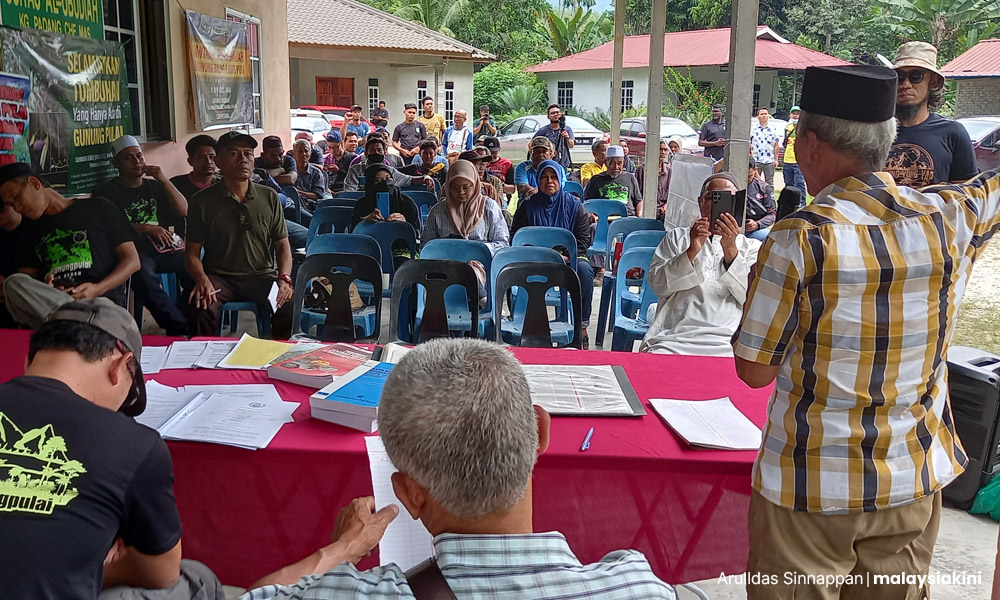Prior to the 2018 general election, then-opposition leader Muhammad Sanusi Md Nor visited Kampung Che Mas and Kampung Sungai Limau in Baling, Kedah in order to canvas their support.
Five years later, it is the villagers’ turn to seek support from Sanusi - who has since become the Kedah menteri besar - to reject proposed quarries at Gunung Baling and Gunung Pulai.
At a press conference yesterday, Abdullah Zakaria said the villagers have sent 12 letters to Sanusi objecting to the quarries but have not received a response.
“We want the menteri besar, who visited the village while he was the state opposition leader before the 2018 election, to visit the village again and evaluate the situation and the relevancy of the quarry project,” the 62-year-old said.
The villagers, who are mainly paddy farmers and fruit orchard owners, claimed that if approved, the quarry operations would jeopardise their daily lives and livelihoods.
Abdullah said one major concern was that dust from the proposed quarries would further exacerbate existing problems that they claimed affected the yield of paddy and fruits in the village.

“Now, the dust from a quarry at a distance of 4km affects Kampung Che Mas, especially during the dry season.
“The whole house will be blanketed with quarry dust. Everyone suffers from sneezing and skin irritation problems and the quarry existed for the last forty years,” he said.
Citing a preliminary Environmental Impact Assessment (EIA) report, the group said the proposed quarry in Gunung Pulai is just 150m away from the nearest residential area, while the Gunung Baling quarry would be 990m away.
Environmental activist Mohd Sobri Ramlee, from Pertubuhan Alam Sekitar Sejahtera Malaysia (Grass) Kedah, said the distance of Gunung Pulai quarry in particular was not in compliance with guidelines for developments in environmentally sensitive areas.
This is because the guidelines require a quarry to have a buffer zone of at least 500m or three times the distance of the height of the limestone cliff being excavated from the nearest residential area.
Besides the potential impact on health and agriculture, Kampung Sungai Limau resident Kamaruddin Zakaria, 57, said the proposed projects could also hurt the local tourism industry.
“The Baling hills are also a popular tourism spot among hikers as people from other states as far as Selangor and Johor come here for hill trekking, and many youths here work as guides to hikers,” he added.
Protect catchment areas
Kampung Che Mas villager Yusof Abdullah, 70, meanwhile, urged the state government to protect catchment areas to safeguard water resources and prevent future flooding.

“We want the habitat that we have today to be retained. The proposed quarries will affect the livelihood of the local residents as it also creates hardship and difficulty, and destroys the environment,” he added.
Malaysiakini has contacted the state Environment Department for comment on whether the EIA for the project has been approved.
Meanwhile, Sobri said according to the Baling Local Plan 2020, which was gazetted in 2011, the proposed quarry sites were originally designated as forest zones.
Hence, he questioned how the state Urban and Rural Development Department could have converted the proposed sites into quarry zones.
“According to the Sub-section 16(1) of the Urban and Rural Planning Act 1976 the state department cannot convert forest zone to quarry zone,” he said.
Weighing in further on the importance of preserving Gunung Baling and Gunung Pulai, Sobri said both sites are ecologically important.
Namely, he noted how a survey by the Forest Research Institute Malaysia (Frim) in 2019 found that a unique species of flora known as Sohmaea Teres was only found in the range of Gunung Baling and Gunung Pulai.
Sobri added that the sites also have significant historical value.
“Historians, National Heritage Department, and archaeology experts have said both the hills have a high value in history and archaeology as humans have lived in the hills as early as 16,000 to 17,000 years ago,” he said. - Mkini




No comments:
Post a Comment
Note: Only a member of this blog may post a comment.